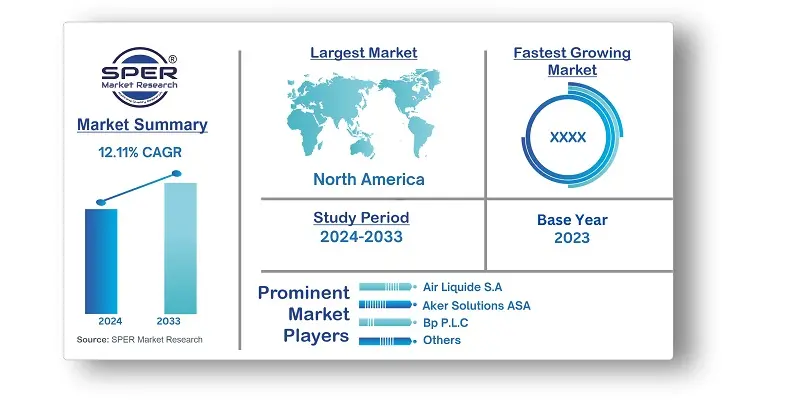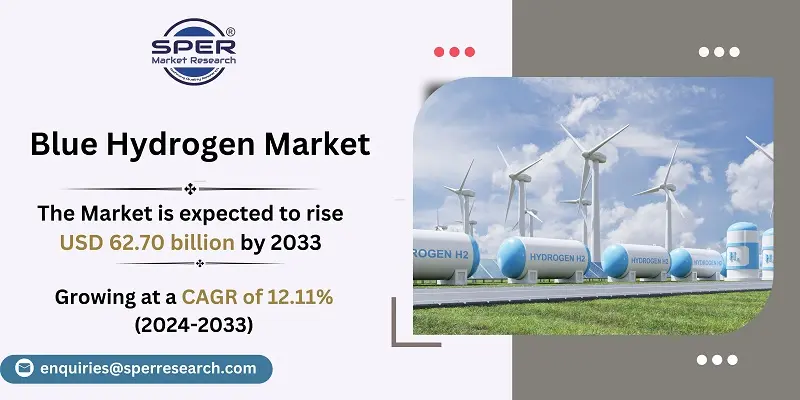
Blue Hydrogen Market Growth, Size, Trends, Demand, Revenue, Challenges and Future Outlook
Blue Hydrogen Market Size- By Technology, By End User- Regional Outlook, Competitive Strategies and Segment Forecast to 2033
| Published: May-2024 | Report ID: CHEM2448 | Pages: 1 - 211 | Formats*: |
| Category : Chemical & Materials | |||
- In March 2022: The new liquid hydrogen production facility in Casa Grande, Arizona, is being built and run, according to an announcement made by Air Products Inc. It is planned to become operational by 2023 and be a zero-carbon liquid hydrogen facility.
- In January 2022: A contract for the building and delivery of a 24 MW hydrogen plant has been signed by Linde plc and Yara.


| Report Metric | Details |
| Market size available for years | 2020-2033 |
| Base year considered | 2023 |
| Forecast period | 2024-2033 |
| Segments covered | By Technology, By End-User |
| Regions covered | North America, Asia-Pacific, Latin America, Middle East & Africa and Europe |
| Companies Covered | Air Liquide S.A, Air Products and Chemicals Inc, Aker Solutions ASA, Aquaterra Energy Ltd, Bp P.L.C, Dastur Energy, ExxonMobil Corporation, INEOS Group Limited, Johnson Matthey, and Linde plc. |
- Governments and policymakers
- Energy companies
- Industrial companies
- Transportation companies
- Investors
| By Technology: |
|
| By End-User: |
|
| By Region: |
|
- Global Blue Hydrogen Market Size (FY’2024-FY’2033)
- Overview of Global Blue Hydrogen Market
- Segmentation of Global Blue Hydrogen Market By Technology (Steam Methane Reforming, Gas Partial Oxidation, Auto Thermal Reforming)
- Segmentation of Global Blue Hydrogen Market By End-User (Petroleum Refineries, Chemical Industry, Power Generation Facilities, Others)
- Statistical Snap of Global Blue Hydrogen Market
- Expansion Analysis of Global Blue Hydrogen Market
- Problems and Obstacles in Global Blue Hydrogen Market
- Competitive Landscape in the Global Blue Hydrogen Market
- Impact of COVID-19 and Demonetization on Global Blue Hydrogen Market
- Details on Current Investment in Global Blue Hydrogen Market
- Competitive Analysis of Global Blue Hydrogen Market
- Prominent Players in the Global Blue Hydrogen Market
- SWOT Analysis of Global Blue Hydrogen Market
- Global Blue Hydrogen Market Future Outlook and Projections (FY’2024-FY’2033)
- Recommendations from Analyst
1.1. Scope of the report1.2. Market segment analysis
2.1. Research data source2.1.1. Secondary Data2.1.2. Primary Data2.1.3. SPER’s internal database2.1.4. Premium insight from KOL’s2.2. Market size estimation2.2.1. Top-down and Bottom-up approach2.3. Data triangulation
4.1. Driver, Restraint, Opportunity and Challenges analysis4.1.1. Drivers4.1.2. Restraints4.1.3. Opportunities4.1.4. Challenges4.2. COVID-19 Impacts of the Global Blue Hydrogen Market.
5.1. SWOT Analysis5.1.1. Strengths5.1.2. Weaknesses5.1.3. Opportunities5.1.4. Threats5.2. PESTEL Analysis5.2.1. Political Landscape5.2.2. Economic Landscape5.2.3. Social Landscape5.2.4. Technological Landscape5.2.5. Environmental Landscape5.2.6. Legal Landscape5.3. PORTER’s Five Forces5.3.1. Bargaining power of suppliers5.3.2. Bargaining power of buyers5.3.3. Threat of Substitute5.3.4. Threat of new entrant5.3.5. Competitive rivalry5.4. Heat Map Analysis
6.1. Global Blue Hydrogen Market Manufacturing Base Distribution, Sales Area, Product Type6.2. Mergers & Acquisitions, Partnerships, Product Launch, and Collaboration in Global Blue Hydrogen Market
7.1. Global Blue Hydrogen Market Size, Share and Forecast, By Technology, 2020-20267.2. Global Blue Hydrogen Market Size, Share and Forecast, By Technology, 2027-20337.3. Steam Methane Reforming7.4. Gas Partial Oxidation7.5. Auto Thermal Reforming
8.1. Global Blue Hydrogen Market Size, Share and Forecast, By End-User, 2020-20268.2. Global Blue Hydrogen Market Size, Share and Forecast, By End-User, 2027-20338.3. Petroleum Refineries8.4. Chemical Industry8.5. Power Generation Facilities8.6. Others
9.1. Global Blue Hydrogen Market Size and Market Share
10.1. Global Blue Hydrogen Market Size and Market Share By Region (2020-2026)10.2. Global Blue Hydrogen Market Size and Market Share By Region (2027-2033)10.3. Asia-Pacific10.3.1. Australia10.3.2. China10.3.3. India10.3.4. Japan10.3.5. South Korea10.3.6. Rest of Asia-Pacific10.4. Europe10.4.1. France10.4.2. Germany10.4.3. Italy10.4.4. Spain10.4.5. United Kingdom10.4.6. Rest of Europe10.5. Middle East and Africa10.5.1. Kingdom of Saudi Arabia10.5.2. United Arab Emirates10.5.3. Qatar10.5.4. South Africa10.5.5. Egypt10.5.6. Morocco10.5.7. Nigeria10.5.8. Rest of Middle-East and Africa10.6. North America10.6.1. Canada10.6.2. Mexico10.6.3. United States10.7. Latin America10.7.1. Argentina10.7.2. Brazil10.7.3. Rest of Latin America
11.1. Air Liquide S.A,11.1.1. Company details11.1.2. Financial outlook11.1.3. Product summary11.1.4. Recent developments11.2. Air Products and Chemicals Inc11.2.1. Company details11.2.2. Financial outlook11.2.3. Product summary11.2.4. Recent developments11.3. Aker Solutions ASA11.3.1. Company details11.3.2. Financial outlook11.3.3. Product summary11.3.4. Recent developments11.4. Aquaterra Energy Ltd11.4.1. Company details11.4.2. Financial outlook11.4.3. Product summary11.4.4. Recent developments11.5. Bp P.L.C11.5.1. Company details11.5.2. Financial outlook11.5.3. Product summary11.5.4. Recent developments11.6. Dastur Energy11.6.1. Company details11.6.2. Financial outlook11.6.3. Product summary11.6.4. Recent developments11.7. ExxonMobil Corporation11.7.1. Company details11.7.2. Financial outlook11.7.3. Product summary11.7.4. Recent developments11.8. INEOS Group Limited11.8.1. Company details11.8.2. Financial outlook11.8.3. Product summary11.8.4. Recent developments11.9. Johnson Matthey11.9.1. Company details11.9.2. Financial outlook11.9.3. Product summary11.9.4. Recent developments11.10. Linde plc11.10.1. Company details11.10.2. Financial outlook11.10.3. Product summary11.10.4. Recent developments11.11. Others
SPER Market Research’s methodology uses great emphasis on primary research to ensure that the market intelligence insights are up to date, reliable and accurate. Primary interviews are done with players involved in each phase of a supply chain to analyze the market forecasting. The secondary research method is used to help you fully understand how the future markets and the spending patterns look likes.
The report is based on in-depth qualitative and quantitative analysis of the Product Market. The quantitative analysis involves the application of various projection and sampling techniques. The qualitative analysis involves primary interviews, surveys, and vendor briefings. The data gathered as a result of these processes are validated through experts opinion. Our research methodology entails an ideal mixture of primary and secondary initiatives.



Frequently Asked Questions About This Report
PLACE AN ORDER
Year End Discount
Sample Report
Pre-Purchase Inquiry
NEED CUSTOMIZATION?
Request CustomizationCALL OR EMAIL US
100% Secure Payment






Related Reports
Our Global Clients
Our data-driven insights have influenced the strategy of 200+ reputed companies across the globe.




















